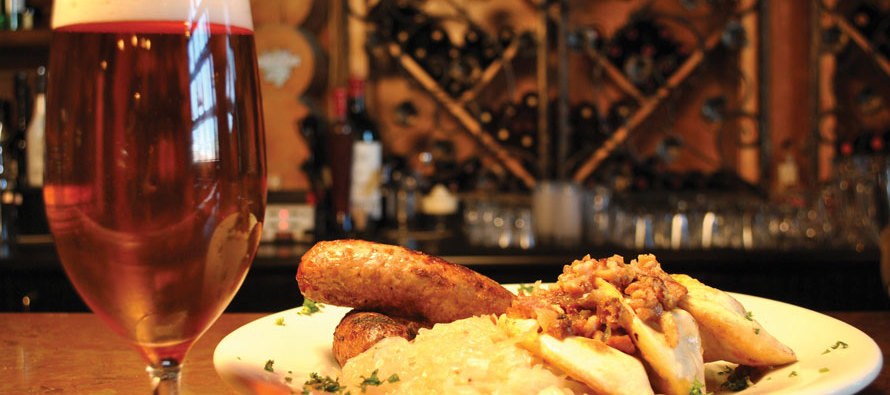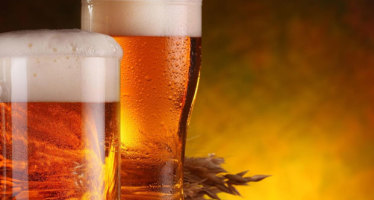No Pinot, Please Pour Me A Pint

When most people think of pairing beer with a meal, the first thought (and only thought in many cases) is pairing a Bud with a hotdog at a baseball game. This is a fine pairing and a great American tradition, but a new American tradition has been brewing over the past 30 years. This new tradition is American craft beer. Craft beer is difficult to categorize, but speaking in general terms, it’s made in small batches, using the highest quality ingredients available. The result is an authentic, complex beverage, made with pride and passion.
Customs evolve slowly, and dinner pairings tend to be focused on wine, but craft beer offers countless options to pair with food. Both wine and beer’s acidity tends to calm salts and fats, allowing the food’s flavors to come through. While beer and wine have some similar qualities, craft beer takes it to another level due to the varying acidity attributes and the hop bitterness levels provided by different beer styles. The acidity and bitterness calm a food’s richness and residual sugars. Additionally, carbonation helps cleanse the pallet, while the unique characteristics of malt, hop and yeast in each variety add to the dining experience.
At Benson Brewery we strongly believe in eating and drinking better, and this experience is enhanced by pairing the meal with the proper beer. For your next dinner party or company event a nice twist may be to hold a pairing dinner with the ultimate beverage: craft beer. The following bullet points from the Brewers Association describe the basic taste elements to focus on while considering what beers to pair with a meal. The dominant craft beer taste elements will contrast against the food’s taste elements, so that the beer and food flavors shine.
- Sweet calms sweet – allowing other flavors rise to the surface. Examples: peas and carrots; milk and cookies; stout and vanilla ice cream floats.
- Acidic calms salt – acid cuts the salt and balances flavor to create a “cleanness”. Examples: ceviche and tortilla chips; tomatoes and mozzarella cheese; pickles and a corned beef sandwich.
- Bitter calms sweet – allowing other flavors rise to the surface. Example: the sweet of malted barley is calmed and balanced by the bitterness of hop alpha acids. Think: An India pale ale’s bitterness calms the sweetness of the icing on a carrot cake. Perhaps something like a bitter arugula salad with sweet dried cranberries, or perhaps more commonly, your morning coffee with cream and sugar.
- Umami complements umami. Examples: mushrooms on fettuccine alfredo; parmesan cheese on spaghetti and meatballs; an aged old ale and holiday fruitcake.
Now that we have the basic taste elements under our belts, we need to develop a high-level understanding of the beer categories and their general flavor profiles. We classify our beers by the seven flavor categories created by Greg Engert of the neighborhood restaurant group in Washington, DC. These categories are crisp, hop, malt, roast, smoke, fruit and spice, and tart and funky. The details of these categories go well beyond the scope of this article, but the following brief descriptions of the more common of these categories will act as a guide and help you narrow your beer choices down for your meal pairing.
- Crisp beers such as English blonde ales, pilsners and Vienna lagers tend to be lighter body, lower alcohol and cleaner flavor. Crisp beers tend to pair well with spicier dishes, seafood and salads.
- Hop beers are all about the aroma and bitterness provided from the substantial addition of hops throughout the brewing process. Hop beers span the color spectrum and have varying degrees of alcohol. India pale ales, American amber, and ordinary bitters are all examples from the hop category. Hoppy beers (not to be confused with happy beer – even though hoppiness is happiness for hop heads) are great beers to pair with pub food and food typically present at BBQs. Beers with an elevated hop profile complement fried foods, burgers, hard cheeses and rich foods.
- Malt beers tend to have high levels of sweetness, often yielding flavors such as deep toffee, nut and caramel. As you may have deduced from the description, these beers tend to have a golden copper to deep brown color and can range from light to full-bodied. We would recommend pairing malty beers such as Dunkel Lager, Wee Heavy Scotch Ale, and Irish Red Ale with root vegetables, a nice winter stew, blue cheese, wild game and pork dishes.
- Roast beers usually have coffee, chocolate, plum and cherry flavors associated with them and tend to have a creamy mouth feel, complemented by a deep copper to black color. Many people see a dark beer and assume it’s harsh, but that is generally not the case. If you are a coffee or chocolate fanatic, there is a good chance you will really enjoy darker beers and we encourage you to try one. Roast beers pair well with desserts, game, blackened dishes and some types of seafood. Common roast beers for this category are sweet stout, American brown ale and robust porters.
- The last flavor profile we will cover is the fruit and spice category, which includes such beers as tripel, Belgian strong dark ale, kristalweizen and saisons. These beers have a vast range of alcohol, colors and an infinite range of flavors. Fruit and spicy beers rarely have hop character and tend to be defined by the bold fruit and spice flavors they encompass. The sweetness of these beers balances out spicy dishes, but also complement shellfish, cured meats and poultry. At Benson Brewery we have a spiced mild English ale called Karha-T. Karha is the miracle blend of spices that give chai tea its unique flavor and aroma. In our Karha-T, Head Brewer Andy Elliott infuses a mild English ale with fresh ginger, green and black cardamom pods, cinnamon sticks, star anise, fennel, black and pink whole peppercorn, clove, almonds, rose petals, saffron, whole nutmeg and coriander. This session beer has a very unique flavor and we found Karha-T pairs very well with spicy sausages as well as cashew ice cream and other desserts.
Now that you are beginning to discover craft beer is a worthy(ier) food pairing partner and are armed with a basic understanding of the flavor profiles, you can start to explore the options for hosting a beer pairing dinner at your home or restaurant. While planning your pairing dinner, have fun with it and pick a theme, like a vegan beer dinner or a dinner that focuses on foods of a particular region. This will help you narrow down beer and food options to a more manageable list of choices. Pairing dinners should be four or five courses with a dessert option – and remember moderation is a good thing. Test the pairings out in advance to ensure your choices are successful, include plenty of vegetables and don’t focus excessively on pairing with proteins.
The beers don’t need to be full 16oz pints. Instead, go with 4oz pours for each course since the overall goal is to have the guest remember the enjoyable dining experience and not drink in excess. It can be daunting to host a pairing dinner so focus on the original intent of hosting; it’s to have fun and enjoy the quality time you are spending with your friends and family. Relax, have a pre-dinner “sample” and think about how craft beer is about to be elevated to its proper place at the dinner table as the ultimate pairing beverage. Cheers!
Related Articles
Perfect Pour: A Craft Cocktail Competition
What comes to your mind when you envision a fundraiser? I’m used to charity events where there’s a silent auction,
No Bubble Trouble
I am coming up on my 20-year anniversary as a bartender/hospitality professional, which has caused me to reflect on how
Fall Beers to Consider
Soon we will be in the last gasps of the hot and humid summer, a time I loathe – mainly
No comments
Write a commentOnly registered users can comment.














